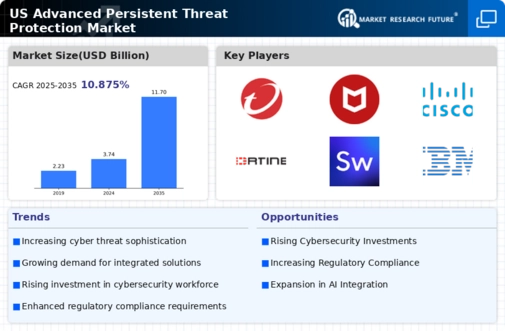The US Advanced Persistent Threat Protection Market is characterized by a dynamic competitive landscape where various cybersecurity solutions are deployed to counteract sophisticated cyber threats. Advanced Persistent Threats, or APTs, are targeted cyberattacks that seek to infiltrate networks and extract sensitive information over extended periods. As businesses increasingly adopt cloud solutions, mobile computing, and interconnected devices, the necessity for robust protection mechanisms has amplified. Market players in this space focus on delivering innovative solutions, creating alliances, and conducting strategic mergers and acquisitions to enhance their capabilities.
The competition is driven by the need for advanced threat detection, real-time monitoring, and rapid response to incidents, making it essential for companies to stay ahead in technology, threat intelligence, and customer service.Trend Micro has established a significant presence in the US Advanced Persistent Threat Protection Market, providing a comprehensive suite of cybersecurity solutions designed to mitigate potential threats effectively. The company's solutions are recognized for their strong detection and response capabilities, which are powered by sophisticated machine learning and artificial intelligence technologies.
Trend Micro's strengths in the market include its extensive research and development initiatives that lead to continuous innovation in threat detection and remediation. Moreover, their partnerships with other technology firms help enhance their product offerings, allowing for seamless integration into various IT environments. The organization's proactive approach to updating its security protocols in response to emerging threats further solidifies its standing in this competitive market, making it a trusted choice for organizations across multiple sectors.McAfee holds a prominent position in the US Advanced Persistent Threat Protection Market, known for its comprehensive cybersecurity solutions that address evolving threat landscapes.
McAfee’s key products include endpoint security, cloud security solutions, and threat intelligence services that cater to a wide range of industries. The company’s strengths lie in its integrated approach, which combines advanced analytics, behavioral analysis, and real-time threat intelligence to provide customers with robust protection against APTs. McAfee's commitment to innovation is evident through its continuous development of new technologies and features that enhance user experiences. The company's strategic merger and acquisition activities have allowed it to broaden its capabilities and market reach, solidifying its role as a key player in the competitive landscape of cybersecurity within the United States.
These factors collectively position McAfee as a formidable competitor in the Advanced Persistent Threat Protection Market, underscoring its relevance in addressing the cybersecurity needs of modern organizations.


























Leave a Comment